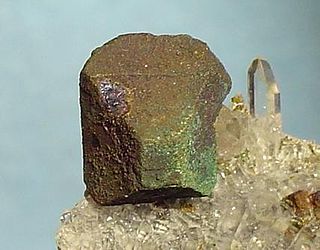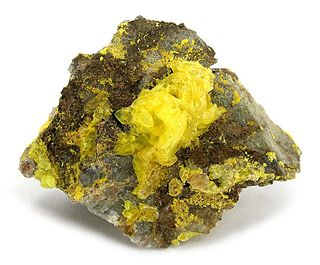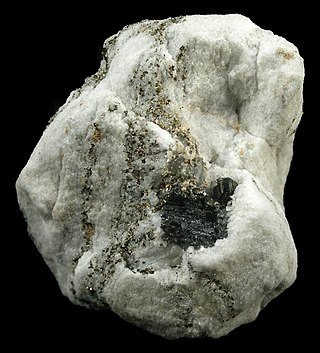
Bornite, also known as peacock ore, is a sulfide mineral with chemical composition Cu5FeS4 that crystallizes in the orthorhombic system (pseudo-cubic).

Cassiterite is a tin oxide mineral, SnO2. It is generally opaque, but it is translucent in thin crystals. Its luster and multiple crystal faces produce a desirable gem. Cassiterite was the chief tin ore throughout ancient history and remains the most important source of tin today.

Acanthite is a form of silver sulfide with the chemical formula Ag2S. It crystallizes in the monoclinic system and is the stable form of silver sulfide below 173 °C (343 °F). Argentite is the stable form above that temperature. As argentite cools below that temperature its cubic form is distorted to the monoclinic form of acanthite. Below 173 °C acanthite forms directly. Acanthite is the only stable form in normal air temperature.

Euclase is a beryllium aluminium hydroxide silicate mineral (BeAlSiO4(OH)). It crystallizes in the monoclinic crystal system and is typically massive to fibrous as well as in slender prismatic crystals. It is related to beryl (Be3Al2Si6O18) and other beryllium minerals. It is a product of the decomposition of beryl in pegmatites.

Adamite is a zinc arsenate hydroxide mineral, Zn2AsO4OH. It is a mineral that typically occurs in the oxidized or weathered zone above zinc ore occurrences. Pure adamite is colorless, but usually it possess yellow color due to Fe compounds admixture. Tints of green also occur and are connected with copper substitutions in the mineral structure. Olivenite is a copper arsenate that is isostructural with adamite and there is considerable substitution between zinc and copper resulting in an intermediate called cuproadamite. Zincolivenite is a recently discovered mineral being an intermediate mineral with formula CuZn(AsO4)(OH). Manganese, cobalt, and nickel also substitute in the structure. An analogous zinc phosphate, tarbuttite, is known.

Tusionite is a rare colorless to transparent to translucent yellow brown trigonal borate mineral with chemical formula: MnSn(BO3)2. The mineral is composed of 18.86% manganese, 40.76% tin, 7.42% boron, and 32.96% oxygen. It is a late stage hydrothermal mineral and occurs rarely in granite pegmatites in miarolitic cavities.
Saliotite is a rare colorless to pearl white phyllosilicate mineral in the smectite group with formula (Li,Na)Al3(AlSi3O10)(OH)5. It is an ordered 1:1 interstratification of cookeite and paragonite. It has perfect cleavage, a pearly luster and leaves a white streak. Its crystal structure is monoclinic, and it is a soft mineral with a hardness rated 2-3 on the Mohs scale.

Chloritoid is a silicate mineral of metamorphic origin. It is an iron magnesium manganese alumino-silicate hydroxide with formula (Fe, Mg, Mn)
2Al
4Si
2O
10(OH)
4. It occurs as greenish grey to black platy micaceous crystals and foliated masses. Its Mohs hardness is 6.5, unusually high for a platy mineral, and it has a specific gravity of 3.52 to 3.57. It typically occurs in phyllites, schists and marbles.
Zincobotryogen is a hydrous sulfate mineral with the chemical formula (Zn,Mg,Mn)Fe3+(SO4)2(OH)·7H2O. It forms bright orange red monoclinic prismatic crystals that exhibit a vitreous to greasy luster. Its specific gravity is 2.201 and it has a Mohs hardness of 2.5.

Zirconolite is a mineral, calcium zirconium titanate; formula CaZrTi2O7. Some examples of the mineral may also contain thorium, uranium, cerium, niobium and iron; the presence of thorium or uranium would make the mineral radioactive. It is black or brown in color.
Cabriite (Pd2SnCu) is a mineral first found in the eastern Siberian region of Russia and named for the Canadian mineralogist Louis J. Cabri (born 1934).
Indite is an extremely rare indium-iron sulfide mineral, found in Siberia. Its chemical formula is FeIn2S4.

Cadwaladerite is a rare aluminium halide mineral with formula: AlCl(OH)2·4(H2O). It was reported for an amorphous substance associated with sulfate minerals and embedded in a halite crystal cluster. Its status is uncertain due to inadequate data. It was first described in 1941 for an occurrence in mine dumps of the Victoria Segunda mine Cerros Pintados, Iquique province, Tarapacá Region, Chile. It was named for Charles Meigs Biddle Cadwalader, president of the Academy of Natural Sciences. Lesukite was discredited (IMA2018-H).
Dzhalindite is a rare indium hydroxide mineral discovered in Siberia. Its chemical formula is In(OH)3.

Imogolite is an aluminium silicate clay mineral with the chemical formula Al2SiO3(OH)4. It occurs in soils formed from volcanic ash and was first described in 1962 for an occurrence in Uemura, Kumamoto prefecture, Kyushu Region, Japan. Its name originates from the Japanese word imogo, which refers to the brownish yellow soil derived from volcanic ash. It occurs together with allophane, quartz, cristobalite, gibbsite, vermiculite and limonite.

Liebigite is a uranium carbonate mineral with the chemical formula: Ca2(UO2)(CO3)3·11H2O. It is a secondary mineral occurring in the oxidizing zone of uranium-bearing ores. It is green to yellow green in colour. It has a Mohs hardness of about 3. Liebigite, like some other uranium minerals, is fluorescent under UV light and is also translucent. It crystallizes in the orthorhombic system, but only rarely forms distinct crystals. It typically forms encrustations or granular aggregates.
Urusovite is a rare copper aluminium arsenate mineral with formula: CuAlAsO5. It is a monoclinic-prismatic light green mineral.
Lithiophosphate is a natural form of (pure) lithium orthophosphate. It is an exceedingly rare mineral, occurring in some special types of pegmatites.
Faizievite is a very rare mineral with the formula K2Na(Ca6Na)Ti4Li6Si24O66F2. This triclinic mineral is chemically related to baratovite and katayamalite. Faizievite is a single-locality mineral, coming from the moraine of the Darai-Pioz glacier, Tien Shan Mountains, Tajikistan. Alkaline rocks of this site are famous for containing numerous rare minerals, often enriched in boron, caesium, lithium, titanium, rare earth elements, barium, and others.

Sartorite is a lead arsenic sulfide with the chemical formula PbAs2S4 and as type locality the Lengenbach Quarry in Legenbach, Binnental, Valais, Switzerland. Historically, sartorite has been thought isomorphic to chalcostibite, emplectite, and zinckenite, but was definitively distinguished from the others in 1939.












